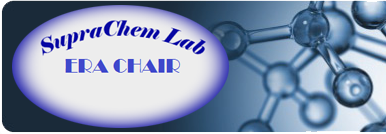During the month of June, the SupraChem Lab the new recruited members were trained on the equipment already existing in PPIMC. The general policy of PPIMC offer full access to high level equipment and instruments to all researcher in the institute but however training to use this stat of art equipment is required. The new recruited staff participated in seven days training on the most important equipment. This training aimed also to facilitate the integration of the new members both in the structure of IntelCentre and in the structure of PPIMC.
Organisation |
Instrument |
Description |
Monday 20.06.2016
Trainer
Dr. Liviu Sacarascu |
Bruker-Nanostar U
Small angle X-ray scattering analysis |
The NANOSTAR U with its incomparable modularity is an ideal solution for analyzing molecular structures ranging from 1 nm to 125 nm and nanostructured surfaces. The 3-pinhole collimation system provides a precisely parallel X-ray beam with high intensity and virtually no background so that fast measuring times and extremely high resolution can be achieved. Consequently, very weakly scattering samples can be analyzed as well as very large structures. The modular design permits setting the detector-to-sample distance from 11.5 mm up to 1070 mm. Hence, the entire range from SAXS to WAXS can be covered. |
Tuesday 21.06.2016
and
Wednesday 22.06.2016
Trainer
Dr. Florica Doroftei |
Hitachi High-Tech HT7700 Transmission Electron Microscope |
The HT7700 was designed with groundbreaking features, chief among these are a superior level of operability and an extensive range of useful digital imaging functions. These features ensure usability across the broadest possible range of applications fields, from the main application area of soft carbon based materials to nanotechnology and biomedical. Furthermore, the decision to integrate a high resolution digital camera and microscope operation has made the system control simplified using one monitor screen possible, which allows for sample observation even under ordinary room lighting.
The HT7700 in PPIMC was installed in a configuration which is unique in Europe: the microscope works in TEM, STEM (bright and dark fields), CRYO TEM and TEM-TOMOGRAPHY modes. This complex instrument allows a deep study of a large variety of materials impossible until now with the conventional TEMs. |
Monday 27.06.2016
Trainer
Dr. Mihai Brebu |
Brookhaven WGE SEC 3010
High-tech Multidetection Size Exclusion Chromatograph |
This instrument is a high-tech multidetection size exclusion chromatograph designed for high precision molecular weights measurements including absolute values. With this system one can determine Mark-Houwink coefficients for a sample with a single injection, or perform branching calculations without assumptions. |
Tuesday 28.06.2016
Trainer
Dr. Alina Niculescu |
NMR BRUKER AVANCE 400 DPX |
The Bruker DPX 400 has a broadband probe with 1H Channel and X-Channel tunable from (30-300 MHz). Both Channels may be tuned researchers. The probe has gradient capabilities for pulse programs, but no 2H gradient shimming. The 400 has variable temperature capabilities. The Bruker PDX 400 provides answers to key chemical questions: reaction yield, mechanistic insights and reaction kinetics. Harness NMR data are important to make strategic process chemistry decisions. |
Wednesday 29.06.2016
Trainer
Dr. Nicolae Fifere |
UV-Viz SPECORD 200 Analytik Jena |
SPECORD UV-Vis instrument offer reliability, user friendliness and flexibility for precise, very easy and versatile UV/Vis analysis. They guarantee highest quality, maximum performance and extreme durability. The monochromator with imaging holographic grating enables stray light reduction and absolutely precise measuring results. The minimized number of movable components ensure best reliability, notably improved signal-to-noise ratio and best energy throughput |
Thursday 30.06.2016
Trainer
Dr. Mihaela Avadanei
|
FTIR, model Bruker Vertex 70 |
VERTEX 70 series offer unmatched performance and versatility for demanding analytical and research applications. Its innovative design results in the highest flexibility and highest performance. The data acquisition is based on two channel ADCs with 24-bit dynamic range, which are running in parallel and integrated into the detector preamplifier electronics. This advanced DigiTect technology prevents external signal disturbance and guarantees the highest signal-to-noise ratio. The new VERTEX FM functionality provides the unique possibility to acquire a complete far and mid IR spectrum from 6000 cm-1 to 80 cm-1 (or to 50 cm-1 with the VERTEX 70v vacuum optics bench) in a single step measurement. |



